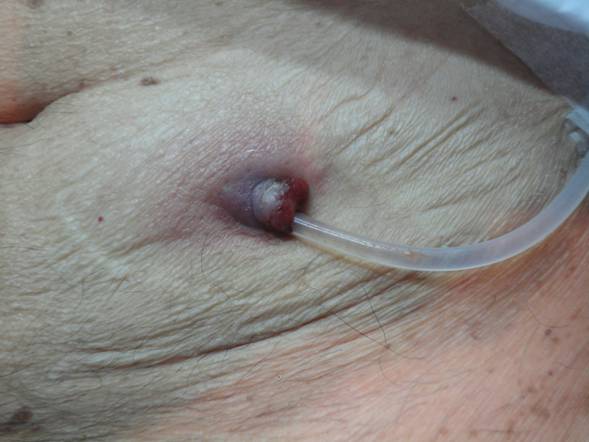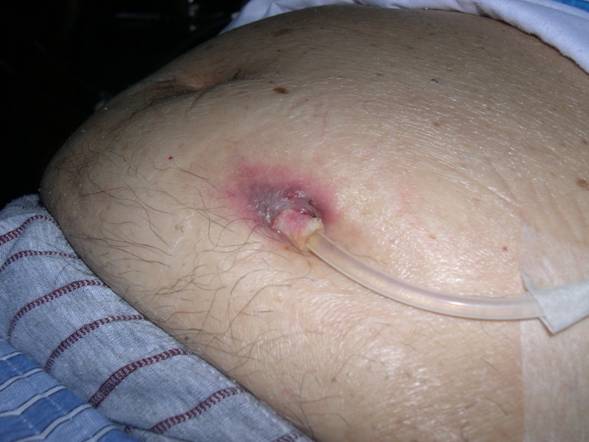Indice del volumen Volume index
Comité Editorial Editorial Board
Comité Científico Scientific Committee
- Local topic with silver nitrate pencil: This treatment is not recommended when the granuloma looks very exudative and has fissures in its surface. It can also irritate surrounding healthy skin.
- Acetamidohexaenoic acid + gentamicin (ointment): This treatment is used in different dermatological lesions: superficial cutaneous ulcers (affects up to the superficial dermis) or medium ulcers (affects the deep dermis and even the hypodermis), pericolostomy dermatitis and exit sites (equivocal or infected) of the peritoneal dialysis catheter. It has the advantage of not irritating the healthy skin areas which surround the granuloma, which makes its application easier to the patient.
SURGERY OF CUTANEOUS EXCISION AS TREATMENT TO EXIT SITE GRANULOMA RELATED TO PERITONEAL CATHETER REFRACTORY TO MEDICAL TREATMENT
Enz1, Ferrario D1, Rivera H2, Zambrano L2, Musso CG2
1Departments of Dermatology and 2Nephrology
Hospital Italiano de Buenos Aires.
Buenos Aires, Argentina.
carlosmusso @ gmail.com
Rev Electron Biomed / Electron J Biomed 2012;2:61-64.-
SUMMARY:
Exit site granuloma is one of the most frequent complications associated to peritoneal dialysis catheter, which usually solves by medical treatment, but sometimes it only solves by surgery.
In the following reports we present a clinical case which represents an example of this.
KEYWORDS: Granuloma. Cutaneous surgery. Peritoneal dialysis
RESUMEN:
El granuloma de sitio de salida es una de las complicaciones más frecuentes asociadas al catéter de diálisis peritoneal, la cual suele resolverse mediante tratamiento médico, sin embargo a veces sólo resuelve con tratamiento quirúrgico.
En el siguiente reporte presentamos un caso clínico que constituye un ejemplo de ello.
PALABRAS CLAVES:Granuloma. Escisión cutánea. Diálisis peritoneal
INTRODUCTION
Exit site granuloma is one the most frequent complications associated to peritoneal dialysis catheter, and needs treatment to prevent future peritoneal infections1. Among the most commonly proposed treatments for its resolution are a local treatment with silver nitrate and/or by applying an acetamidohexanoic acid based ointment2.
In this report we present the case of a patient, on peritoneal dialysis, who had an exit site granuloma which was not only of a considerable size (1cm x 1 cm), but also refractory to several therapeutic measures and eventually required cutaneous surgery for its resolution.
CASE REPORT:
Patient, male, 83 years old, on peritoneal dialysis (CAPD) with 10 months of evolution, who developed a peritoneal catheter exit site granuloma (Figure 1), which did not secrete and according to its appearance corresponded to the category "equivocal" of Twardowski's classification (Table 1).

Table 1 : Exit site types: Twardowski classification
The general procedures for the exit site were: daily cleaning (twice a day) with soap and water, dry locally using a gauze, and cover the site with a sterile gauze held by hypoalergenic adhesive tape.
Initially this granuloma was treated by using a topic with a silver nitrate pencil (application: twice a week), and acetamidohexaenoic acid based ointment + gentamicin (application: twice a day).
Since granuloma not only did not solve, but continued growing and reaching big dimensions, and since this sort of lesion is a kind of subclinical infection, there is the concrete risk that its persistence leads to an acute exit site, tract and/or peritoneal cavity infection. Therefore, it was decided to surgically extract it by means of the local cutaneous excision technique (anaesthesia with lidocaine and suture with 0-4 nylon), which later evolved to healing completely (Figure 2).
By using this treatment the only documented complication was the extrusion of the external cuff of the peritoneal catheter, which nevertheless did not translate into any clinical complication.
DISCUSSION:
The erradication of an exit site granuloma caused by a peritoneal catheter is vital to reduce the risks of an acute infection setting whose eventual derivations could be to even compromise the catheter's useful life.
Habitual treatments used for this condition are:
In the present reported clinical case the exit site lesion was resolved with cutaneous excision surgery3,4, which, in a case like this, has the advantage in comparison with other techniques (laser, radiofrequency, criosurgery) of involving a lower risk of damage to the catheter and/or leave a great necrotic residual lesion.
Therefore, we conclude that this surgical technique is a good alternative for the treatment of a big exit site granuloma refractory to medical measures
REFERENCES
1.- Kathuria P, Twardowski Z, Nichols W. Peritoneal dialysis access and exit-site care including surgical aspects. In Khanna R, Krediet R. (Eds.) Nolph and Gokal ´s Textbook of Peritoneal Dialysis. New York. Springer. 2009: 371-446
2.- Musso CG, Enz P, Mendoza L, Sosa A, Galimberti R, Imperiali N, Algranati L. Topical treatment of peritoneal catheter-related exit-site granuloma with acetamidohexanoic acid combined with gentamicin. Perit Dial Int. 2006; 26 (4):505-506
3.- Calonje E. Soft-tissue tumours and tumour-like conditions. In Burns T, Breathnach S, Cox N, Griffiths C. (Eds.). Rook´s Textbook of dermatology. Singapore. Wiley-Blackwell. 2010; 56:25-26
4.- Calonje E Mc Kee P, Fletcher C. Tumours of the dermis and subcutaneous fat. In McKee P. (Ed.). Pathology of the skin with clinical correlations. Chicago. Mosby-Wolfe. 1997; 16:7-8
CORRESPONDENCE:
Carlos G. Musso MD, PhD.
Department of Nephrology
Hospital Italiano de Buenos Aires
Argentina
carlosmusso @ gmail.com
Received, May 20, 2012.
Published, August 23, 2012


